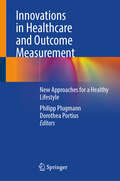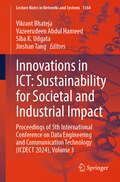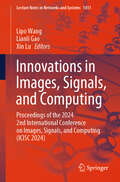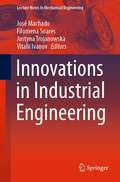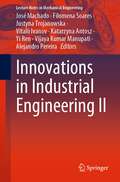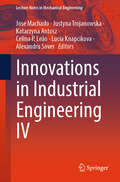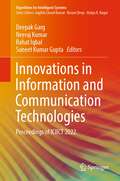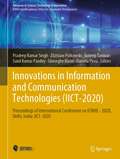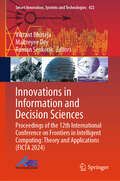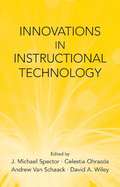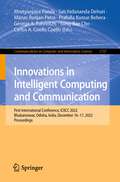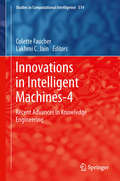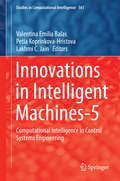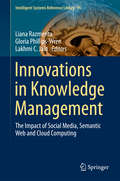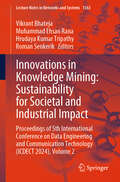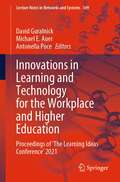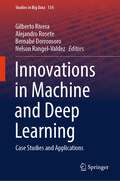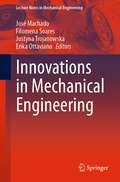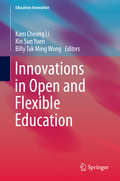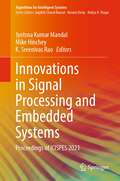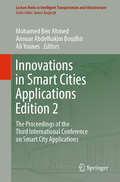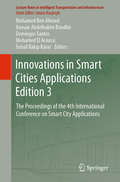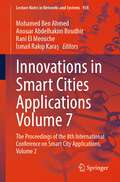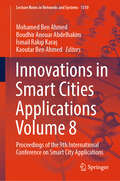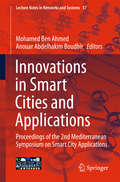- Table View
- List View
Innovations in Healthcare and Outcome Measurement: New Approaches for a Healthy Lifestyle
by Philipp Plugmann Dorothea PortiusSeveral innovations have revolutionized the healthcare sector in recent years. Digitalization, personalized medicine, Advanced Cell, and Tissue Engineering, and AI are some keywords associated with improving the prevention and therapy of diseases, i.e., to combat our crisis of non-communicable diseases. One of the key areas where innovation has had a profound impact is precision medicine. Precision medicine seeks to understand the unique genetic, environmental, and lifestyle factors contributing to an individual's health and disease risk. Through advancements in genomics, proteomics, and other molecular profiling techniques, healthcare providers can now gain a deeper understanding of a patient's molecular makeup. This knowledge allows for targeted interventions and therapies tailored to the specific needs of each individual, maximizing treatment efficacy and minimizing adverse effects. Furthermore, the development of advanced diagnostic tools has greatly enhanced the accuracy and efficiency of disease detection and monitoring. Innovations such as high-resolution imaging technologies, wearable sensors, and liquid biopsies have revolutionized the diagnostic landscape. Integrating artificial intelligence (AI) and machine learning (ML) algorithms has further augmented the capabilities of healthcare management and precision medicine capabilities. This book aims to bring up-to-date new ideas, opinions, development, and critical issues in healthcare and personalized medicine. We are interested in relevant articles covering a broad range of topics, such as: • Advances in medical devices• Digitalization and data-driven technologies • AI and algorithm-based drug development (molecule building, enhancement, clinical trials)• Diagnostic imaging• Personalized medicine• Nutrition• Oral health care• Healthcare management in certain diseases and population groups• Regulatory developments• Data management• Digital Healthcare Chapter "Unlocking the Code of Innovation: TRIZ Theory&’s Blueprint for Precision Medicine Breakthroughs" islicensed under the terms of the Creative Commons Attribution 4.0 International License (http://creativecommons.org/licenses/by/4.0/). For further details see licence information in the chapter.
Innovations in ICT: Proceedings of 5th International Conference on Data Engineering and Communication Technology (ICDECT 2024), Volume 3 (Lecture Notes in Networks and Systems #1364)
by Vikrant Bhateja Siba K. Udgata Jinshan Tang Vazeerudeen Abdul HameedThis book includes selected papers presented at the 5th International Conference on Data Engineering and Communication Technology (ICDECT 2024), held at Asia Pacific University of Technology and Innovation (APU, Kuala Lumpur, Malaysia, during 28–29 September 2024. It features advanced, multidisciplinary research towards the design of smart computing, information systems and electronic systems. It also focuses on various innovation paradigms in system knowledge, intelligence and sustainability which can be applied to provide viable solutions to diverse problems related to society, the environment and industry.
Innovations in Images, Signals, and Computing: Proceedings of the 2024 2nd International Conference on Images, Signals, and Computing (ICISC 2024) (Lecture Notes in Networks and Systems #1411)
by Lipo Wang Lianli Gao Xin LuThis book consists of papers on the recent progresses in the state-of-the-art in images, signals, and their intersections with computing. The book can be useful for researchers, including professors, graduate students, as well as R & D staff in the industry, with a general interest in images, signals, and their intersections with computing. The work printed in this book was presented at the 2024 2nd International Conference on Images, Signals, and Computing (ICISC 2024), held from 21-23 September 2024, Chengdu, China. All papers were rigorously peer-reviewed by experts in the areas.
Innovations in Industrial Engineering (Lecture Notes in Mechanical Engineering)
by Filomena Soares José Machado Vitalii Ivanov Justyna TrojanowskaThis book covers a variety of topics in the field of industrial engineering, with a special focus on research and industrial applications aimed at both improving quality of processes and products and contributing to a sustainable economy. Based on a set of papers presented at the 1st International Conference “Innovation in Engineering”, ICIE, held in Guimarães, Portugal, on June 28–30, 2021, it focuses on innovative technologies associated with and strategies for the development of Industry 4.0. The chapters discuss new ways to improve industrial production and supply chain management by applying mathematical and computational methods. They also cover important issues relating to sustainability, education, and collaborations between industry and universities, and national developments. This book, which belongs to a three-volume set, provides engineering researchers and professionals with a timely overview and extensive information on trends and technologies behind the current and future developments of Industry 4.0.
Innovations in Industrial Engineering II (Lecture Notes in Mechanical Engineering)
by Yi Ren Filomena Soares José Machado Vitalii Ivanov Justyna Trojanowska Vijaya Kumar Manupati Alejandro Pereira Katarzyna AntoszThis book covers a variety of topics in the field of industrial engineering, with a special focus on research and industrial applications aimed at both improving quality of processes and products and contributing to a sustainable economy. Based on a set of papers presented at the 2nd International Conference “Innovation in Engineering”, ICIE, held in Minho, Portugal, on June 28–30, 2022, it focuses on innovative technologies associated with and strategies for the development of Industry 4.0. The chapters discuss new ways to improve industrial production and supply chain management by applying mathematical and computational methods. They also cover important issues relating to sustainability, education, and collaborations between industry and universities, and national developments. This book, which belongs to a three-volume set, provides engineering researchers and professionals with a timely overview and extensive information on trends and technologies behind the current and future developments of Industry 4.0.
Innovations in Industrial Engineering IV (Lecture Notes in Mechanical Engineering)
by Justyna Trojanowska Jose Machado Lucia Knapcikova Katarzyna Antosz Celina P. Leão Alexandru SoverThis book reports on innovations and engineering achievements of industrial relevance, with a special emphasis on industrial engineering developments aimed at improving the quality of processes and products in the context of a sustainable economy. It gathers peer-reviewed papers presented at the 4th International Conference &“Innovation in Engineering&”, ICIE 2025, held on June 18-20, 2025, in Prague, Czech Republic. All in all, this third volume of a three-volume set provides engineering researchers and professionals with a timely snapshot of technologies and strategies that should help shaping different industrial sectors to improve production efficiency, industrial sustainability, and human well-being.
Innovations in Information and Communication Technologies: Proceedings of ICIICT 2022 (Algorithms for Intelligent Systems)
by Neeraj Kumar Deepak Garg Suneet Kumar Gupta Rahat IqbalThis book gathers selected papers presented at the International Conference on Innovations in Information and Communication Technologies (ICIICT 2022), held in Thailand during April 15–16, 2022. It presents the works on the intersection of the Computer Science and Communication Engineering. Topics covered in the book include communications engineering, Internet and web technology, computer and information science, artificial intelligence, data science and management, and ICT applications.
Innovations in Information and Communication Technologies: Proceedings of International Conference on ICRIHE - 2020, Delhi, India: IICT-2020 (Advances in Science, Technology & Innovation)
by Pradeep Kumar Singh Sudeep Tanwar Zdzislaw Polkowski Sunil Kumar Pandey Gheorghe Matei Daniela PirvuThis edited book is comprised of original research that focuses on technological advancements for effective teaching with an emphasis on learning outcomes, ICT trends in higher education, sustainable developments and digital ecosystem in education, management and industries. The contents of the book are classified as; (i) Emerging ICT Trends in Education, Management and Innovations (ii) Digital Technologies for advancements in education, management and IT (iii) Emerging Technologies for Industries and Education, and (iv) ICT Technologies for Intelligent Applications. The book represents a useful tool for academics, researchers, industry professionals and policymakers to share and learn about the latest teaching and learning practices supported by ICT. It also covers innovative concepts applied in education, management and industries using ICT tools.
Innovations in Information and Decision Sciences: Proceedings of the 12th International Conference on Frontiers in Intelligent Computing: Theory and Applications (FICTA 2024) (Smart Innovation, Systems and Technologies #422)
by Roman Senkerik Vikrant Bhateja Maitreyee DeyThe book presents the proceedings of the 12th International Conference on Frontiers of Intelligent Computing: Theory and Applications (FICTA 2024), held at Intelligent Systems Research Group (ISRG), London Metropolitan University, London, United Kingdom, during June 6–7, 2024. Researchers, scientists, engineers and practitioners exchange new ideas and experiences in the domain of intelligent computing theories with prospective applications in various engineering disciplines in the book. This book is divided into four volumes. It covers broad areas of information and decision sciences, with papers exploring both the theoretical and practical aspects of data-intensive computing, data mining, evolutionary computation, knowledge management and networks, sensor networks, signal processing, wireless networks, protocols and architectures. This book is a valuable resource for postgraduate students in various engineering disciplines.
Innovations in Instructional Technology: Essays in Honor of M. David Merrill
by J. Michael Spector Celestia Ohrazda Andrew Van Schaack David A. WileyM. David Merrill has been active in the field of instructional technology for almost 40 years. His contributions range from basic instructional principles and instructional design theory to development and implementation of learning environments. Innovations in Instructional Technology is a collection of original essays written by leading scholars and practitioners who have worked with and been inspired by Professor Merrill. The chapters in this book represent a sampling of key innovations in the instructional technology field and include knowledge of how people learn, how people solve problems, how designers conceptualize learning spaces, how teachers implement learning activities, and how evaluators assess outcomes.This volume is divided into five basic areas of research in instructional technology, mirroring the diverse contributions of Dr. Merrill's work:*four chapters on learning objects and the notion of reusable components;*three chapters that discuss fundamental aspects of learning and the design of instruction;*three chapters that address innovations in the area of assessment, evaluation, and model validation;*three chapters that concern theories of learning and instruction; and*three chapters on instructional design practice.The book concludes with a chapter outlining Dr. Merrill's responses to challenges, comments, and questions on the future of the field--ranging from the notion of initial passions with regard to instructional technology to connections between theory and practice to questions of conscience--from an expert panel comprised of many of the contributors to the book.As Dave Merrill's work will continue to be required reading for students of instructional technology, Innovations in Instructional Technology is a book that will appeal to students, researchers, and practitioners in the field.
Innovations in Intelligent Computing and Communication: First International Conference, ICIICC 2022, Bhubaneswar, Odisha, India, December 16-17, 2022, Proceedings (Communications in Computer and Information Science #1737)
by George A. Tsihrintzis Satchidananda Dehuri Mrutyunjaya Panda Carlos A. Coello Coello Manas Ranjan Patra Sung-Bae Cho Prafulla Kumar BeheraThis book contains the papers presented at the First International Conference on Innovations in Intelligent Computing and Communication, ICIICC 2021, held in Bhubaneswar, Odisha, India, in December, 2022. The 31 full papers presented were thoroughly reviewed and selected from 78 submissions. They are divided in three tracks with the following topics: Intelligent Computing; Communications; and Machine Learning and Data Analytics.
Innovations in Intelligent Machines-4
by Lakhmi C. Jain Colette FaucherThis research volume is a continuation of our previous volumes on intelligent machine. It is divided into three parts. Part I deals with big data and ontologies. It includes examples related to the text mining, rule mining and ontology. Part II is on knowledge-based systems. It includes context-centered systems, knowledge discovery, interoperability, consistency and systems of systems. The final part is on applications. The applications involve prediction, decision optimization and assessment. This book is directed to the researchers who wish to explore the field of knowledge engineering further.
Innovations in Intelligent Machines-5
by Lakhmi C. Jain Valentina Emilia Balas Petia Koprinkova-HristovaThis research monograph presents selected areas of applications in the field of control systems engineering using computational intelligence methodologies. A number of applications and case studies are introduced. These methodologies are increasing used in many applications of our daily lives. Approaches include, fuzzy-neural multi model for decentralized identification, model predictive control based on time dependent recurrent neural network development of cognitive systems, developments in the field of Intelligent Multiple Models based Adaptive Switching Control, designing military training simulators using modelling, simulation, and analysis for operational analyses and training, methods for modelling of systems based on the application of Gaussian processes, computational intelligence techniques for process control and image segmentation technique based on modified particle swarm optimized-fuzzy entropy.
Innovations in Knowledge Management
by Lakhmi C. Jain Liana Razmerita Gloria Phillips-WrenThis book discusses emerging trends in the field of managing knowledge work due to technological innovations. The book is organized in 3 sections. The first section, entitled "Managing Knowledge, Projects and Networks", discusses knowledge processes and their use, reuse or generation in the context of an organization. The second section, entitled "Managing Knowledge using Social Media", focuses on factors influencing adoption and usage, the role of social media in managing knowledge, and factors that influence employees' acceptance and participation. The third section brings into discussion new approaches and technologies for acquiring knowledge. The book will be useful to both academics engaged in research in knowledge management and practitioners who are considering or implementing strategies for managing one of their most important resources.
Innovations in Knowledge Mining: Proceedings of 5th International Conference on Data Engineering and Communication Technology (ICDECT 2024), Volume 2 (Lecture Notes in Networks and Systems #1363)
by Roman Senkerik Vikrant Bhateja Hrudaya Kumar Tripathy Muhammad Ehsan RanaThis book includes selected papers presented at the 5th International Conference on Data Engineering and Communication Technology (ICDECT 2024), held at Asia Pacific University of Technology and Innovation (APU, Kuala Lumpur, Malaysia, during 28–29 September 2024. It features advanced, multidisciplinary research towards the design of smart computing, information systems and electronic systems. It also focuses on various innovation paradigms in system knowledge, intelligence and sustainability which can be applied to provide viable solutions to diverse problems related to society, the environment and industry.
Innovations in Learning and Technology for the Workplace and Higher Education: Proceedings of ‘The Learning Ideas Conference’ 2021 (Lecture Notes in Networks and Systems #349)
by Antonella Poce Michael E. Auer David GuralnickThis book covers the topics such as online learning methodologies, case studies, new technologies in learning (such as virtual reality, augmented reality, holograms, and artificial intelligence), adaptive learning, and project-based learning. New technologies provide us with new opportunities to create new learning experiences, leveraging research from a variety of disciplines along with imagination and creativity. The Learning Ideas Conference was created to bring researchers, practitioners, and others together to discuss, innovate, and create.The Learning Ideas Conference 2021 was the 14th annual conference and the first under its new name (following on its predecessors, the International Conference on E-Learning in the Workplace and the International Conference on Interactive Collaborative and Blended Learning). The conference was held online from June 14-18, 2021, and included two special tracks: The ALICE (Adaptive Learning via Interactive, Collaborative and Emotional Approaches) Special Track and a track entitled Building a University of Tomorrow, from the Xi'an Jiaotong-Liverpool University (XJTLU) in China.The papers included in this book may be of interest to researchers in pedagogy and learning theory, university faculty members and administrators, learning and development specialists, user experience designers, and others.
Innovations in Machine and Deep Learning: Case Studies and Applications (Studies in Big Data #134)
by Bernabé Dorronsoro Alejandro Rosete Gilberto Rivera Nelson Rangel-ValdezIn recent years, significant progress has been made in achieving artificial intelligence (AI) with an impact on students, managers, scientists, health personnel, technical roles, investors, teachers, and leaders. This book presents numerous successful applications of AI in various contexts.The innovative implications covered fall under the general field of machine learning (ML), including deep learning, decision-making, forecasting, pattern recognition, information retrieval, and interpretable AI. Decision-makers and entrepreneurs will find numerous successful applications in health care, sustainability, risk management, human activity recognition, logistics, and Industry 4.0. This book is an essential resource for anyone interested in challenges, opportunities, and the latest developments and real-world applications of ML. Whether you are a student, researcher, practitioner, or simply curious about AI, this book provides valuable insights and inspiration for your work and learning.
Innovations in Mechanical Engineering (Lecture Notes in Mechanical Engineering)
by Filomena Soares Erika Ottaviano José Machado Justyna TrojanowskaThis book covers a variety of topics in the field of mechanical engineering, with a special focus on methods and technologies for modeling, simulation, and design of mechanical systems. Based on a set of papers presented at the 1st International Conference “Innovation in Engineering”, ICIE, held in Guimarães, Portugal, on June 28–30, 2021, it focuses on innovation in mechanical engineering, spanning from engineering design and testing of medical devices, evaluation of new materials and composites for different industrial applications, fatigue and stress analysis of mechanical structures, and application of new tools such as 3D printing, CAE 3D models, and decision support systems. This book, which belongs to a three-volume set, provides engineering researchers and professionals with extensive and timely information on new technologies and developments in the field of mechanical engineering and materials.
Innovations in Open and Flexible Education (Education Innovation Series)
by Kam Cheong Li Kin Sun Yuen Billy Tak WongThis book covers a broad range of innovations in education, such as flipped classrooms, the educational use of social media, mobile learning, educational resources and massive open online courses, as well as theoretical discussions and practical applications in the use of augmented reality and educational technology to improve student engagement and pave the way for students’ future studies and careers. The case studies and practical applications presented here illustrate the effectiveness of new modes of education in which the latest technologies and innovations are widely used in the global context. Accordingly, the book can help develop readers’ awareness of the potential these innovations hold, thus expanding their expertise and stimulating critical thinking as to how new technologies have made learning and teaching easier in various educational settings.
Innovations in Signal Processing and Embedded Systems: Proceedings of ICISPES 2021 (Algorithms for Intelligent Systems)
by Mike Hinchey Jyotsna Kumar Mandal K. Sreenivas RaoThis book covers four sections such as artificial intelligence and machine learning; VLSI and signal processing; robotics and automation; and communications and networking. This book is a collection of selected papers presented at the First International Conference on Innovations in Signal Processing and Embedded Systems (ICISPES 2021), organized by MLR Institute of Technology, Hyderabad, India, during October 22–23, 2021. The topics covered are advanced communication technologies, IoT-based systems and applications, application AI in computer vision, natural language processing, reinforcement learning, ANN and deep neural networks, RNN, GAN, CNN and RBM, SOC, NOC design, VLSI and CAD/CAM, cross-layer design, fault tolerance and computation theories, FPGA in outer space, nanotechnology, semiconductor technology, signal and image processing, high-performance computing, pattern recognition and computer vision innovations in robotics, reconfigurable robots, and MEMS/NEMS.
Innovations in Smart Cities Applications Edition 2: The Proceedings of the Third International Conference on Smart City Applications (Lecture Notes in Intelligent Transportation and Infrastructure)
by Mohamed Ben Ahmed Anouar Abdelhakim Boudhir Ali YounesThis book highlights cutting-edge research presented at the third installment of the International Conference on Smart City Applications (SCA2018), held in Tétouan, Morocco on October 10–11, 2018. It presents original research results, new ideas, and practical lessons learned that touch on all aspects of smart city applications. The respective papers share new and highly original results by leading experts on IoT, Big Data, and Cloud technologies, and address a broad range of key challenges in smart cities, including Smart Education and Intelligent Learning Systems, Smart Healthcare, Smart Building and Home Automation, Smart Environment and Smart Agriculture, Smart Economy and Digital Business, and Information Technologies and Computer Science, among others. In addition, various novel proposals regarding smart cities are discussed. Gathering peer-reviewed chapters written by prominent researchers from around the globe, the book offers an invaluable instructional and research tool for courses on computer and urban sciences; students and practitioners in computer science, information science, technology studies and urban management studies will find it particularly useful. Further, the book is an excellent reference guide for professionals and researchers working in mobility, education, governance, energy, the environment and computer sciences.
Innovations in Smart Cities Applications Edition 3: The Proceedings of the 4th International Conference on Smart City Applications (Lecture Notes in Intelligent Transportation and Infrastructure)
by Mohamed Ben Ahmed Anouar Abdelhakim Boudhir Domingos Santos Mohamed El Aroussi İsmail Rakıp KarasThis book highlights original research and recent advances in various fields related to smart cities and their applications. It gathers papers presented at the Fourth International Conference on Smart City Applications (SCA19), held on October 2–4, 2019, in Casablanca, Morocco. Bringing together contributions by prominent researchers from around the globe, the book offers an invaluable instructional and research tool for courses on computer science, electrical engineering, and urban sciences. It is also an excellent reference guide for professionals, researchers, and academics in the field of smart cities. This book covers topics including: • Smart Citizenship• Smart Education • Digital Business and Smart Governance • Smart Health Care • New Generation of Networks and Systems for Smart Cities • Smart Grids and Electrical Engineering • Smart Mobility • Smart Security • Sustainable Building • Sustainable Environment
Innovations in Smart Cities Applications Volume 7: The Proceedings of the 8th International Conference on Smart City Applications, Volume 2 (Lecture Notes in Networks and Systems #938)
by Mohamed Ben Ahmed Anouar Abdelhakim Boudhir İsmail Rakıp Karaș Rani El MeoucheMany cities in the developed world are undergoing a digital revolution, and have placed the "smart city" on their list of priorities. Smart cities use technological solutions such as Internet of Things, AI, 5G, Big Data, Cloud computing, Smart Grid, as well as all the emerging technologies of the digital era, to improve the management and efficiency of the urban environment. The aim is to make residents happier, healthier, smarter and more prosperous, and to make the city greener, cleaner, more sustainable, more responsible, more functional, more resilient, and more competitive. Enhanced by extensive research studies and carried out under the guidance of international scientific experts in the field. This book explores various papers related to smart cities, including digital twins, geo-smart information systems, education, healthcare, economy and digital business, building and home automation, environment and agriculture, and information technologies and computer science.
Innovations in Smart Cities Applications Volume 8: Proceedings of the 9th International Conference on Smart City Applications (Lecture Notes in Networks and Systems #1310)
by Mohamed Ben Ahmed Boudhir Anouar Abdelhakim İsmail Rakıp Karaș Kaoutar Ben AhmedThis book discovers the latest technological advances that are transforming our cities into smart and connected spaces. This book presents cutting-edge research and inspiring case studies on urban management, smart mobility and environmental sustainability. With an innovative approach, it explores concrete solutions and future perspectives to improve the quality of urban life. Intended for researchers, professionals and decision-makers, this book is an essential resource to understand and participate in the transformation of smart cities.
Innovations in Smart Cities and Applications: Proceedings Of The 2nd Mediterranean Symposium On Smart City Applications (Lecture Notes In Networks And Systems #37)
by Mohamed Ben Ahmed Anouar Abdelhakim BoudhirThis proceedings book showcases the latest research work presented at the Second Edition of the Mediterranean Symposium on Smart City Application (SCAMS 2017), which was held in Tangier, Morocco on October 15–27, 2017. It presents original research results, new ideas and practical development experiences that concentrate on both theory and practice. It includes papers from all areas of Smart City Applications, e.g. Smart Mobility, Big Data, Smart Grids, Smart Homes and Buildings, clouds, crowds, mashups, social networks, and security issues.The conference stimulated cutting-edge research discussions among pioneering researchers, scientists, industrial engineers, and students from all around the world. The topics covered in this book also focus on innovative issues at the international level by bringing together experts from different countries. The scope of SCAMS 2017 included methods and practices that combine various emerging internetworking and data technologies to capture, integrate, analyze, mine, annotate, and visualize data in a meaningful and collaborative manner. A series of international workshops were organized as invited sessions during the SCAMS 2017:The 2nd International Workshop on Smart Learning & Innovative EducationsThe 1st International Workshop on Smart HealthcareThe 1st International Workshop on Mathematics for Smart CityThe 1st International Workshop Industry 4.0 and Smart Manufacturing
